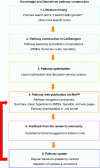Research resource: Gonadotropin-releasing hormone receptor-mediated signaling network in LbetaT2 cells: a pathway-based web-accessible knowledgebase
- PMID: 20592162
- PMCID: PMC2940478
- DOI: 10.1210/me.2009-0530
Research resource: Gonadotropin-releasing hormone receptor-mediated signaling network in LbetaT2 cells: a pathway-based web-accessible knowledgebase
Abstract
The GnRH receptor (GnRHR), expressed at the cell surface of the anterior pituitary gonadotrope, is critical for normal secretion of gonadotropins LH and FSH, pubertal development, and reproduction. The signaling network downstream of the GnRHR and the molecular bases of the regulation of gonadotropin expression have been the subject of intense research. The murine LbetaT2 cell line represents a mature gonadotrope and therefore is an important model for the study of GnRHR-signaling pathways and modulation of the gonadotrope cell by physiological regulators. In order to facilitate access to the information contained in this complex and evolving literature, we have developed a pathway-based knowledgebase that is web hosted. At present, using 106 relevant primary publications, we curated a comprehensive knowledgebase of the GnRHR signaling in the LbetaT2 cell in the form of a process diagram. Positive and negative controls of gonadotropin gene expression, which included GnRH itself, hypothalamic factors, gonadal steroids and peptides, as well as other hormones, were illustrated. The knowledgebase contains 187 entities and 206 reactions. It was assembled using CellDesigner software, which provides an annotated graphic representation of interactions, stored in Systems Biology Mark-up Language. We then utilized Biological Pathway Publisher, a software suite previously developed in our laboratory, to host the knowledgebase in a web-accessible format as a public resource. In addition, the network entities were linked to a public wiki, providing a forum for discussion, updating, and error correction. The GnRHR-signaling network is openly accessible at http://tsb.mssm.edu/pathwayPublisher/GnRHR_Pathway/GnRHR_Pathway_ index.html.
Figures



References
-
- Burger LL, Dalkin AC, Aylor KW, Haisenleder DJ, Marshall JC 2002 GnRH pulse frequency modulation of gonadotropin subunit gene transcription in normal gonadotropes-assessment by primary transcript assay provides evidence for roles of GnRH and follistatin. Endocrinology 143:3243–3249 - PubMed
-
- Dalkin AC, Haisenleder DJ, Ortolano GA, Ellis TR, Marshall JC 1989 The frequency of gonadotropin-releasing-hormone stimulation differentially regulates gonadotropin subunit messenger ribonucleic acid expression. Endocrinology 125:917–924 - PubMed
-
- Layman LC, Cohen DP, Jin M, Xie J, Li Z, Reindollar RH, Bolbolan S, Bick DP, Sherins RR, Duck LW, Musgrove LC, Sellers JC, Neill JD 1998 Mutations in gonadotropin-releasing hormone receptor gene cause hypogonadotropic hypogonadism. Nat Genet 18:14–15 - PubMed
-
- Vrecl M, Heding A, Hanyaloglu A, Taylor PL, Eidne KA 2000 Internalization kinetics of the gonadotropin-releasing hormone (GnRH) receptor. Pflugers Arch 439:R19–R20 - PubMed
-
- Willars GB, Heding A, Vrecl M, Sellar R, Blomenröhr M, Nahorski SR, Eidne KA 1999 Lack of a C-terminal tail in the mammalian gonadotropin-releasing hormone receptor confers resistance to agonist-dependent phosphorylation and rapid desensitization. J Biol Chem 274:30146–30153 - PubMed

